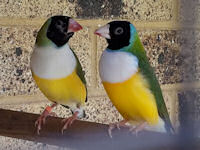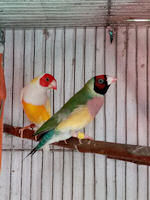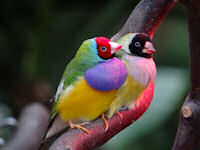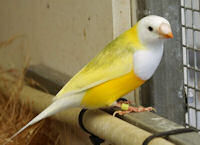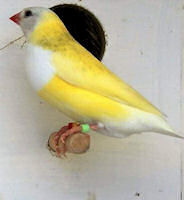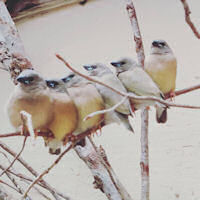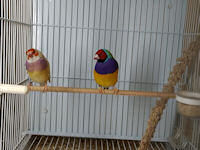Breeding
Introduction
Breeding finches is a massive subject and many books have been written on finches which also include breeding. I plan to highlight the main things to take into account whilst organizing them in to categorize. Being a beginner or an experienced breeder of finches does not matter, there are a lot of factors to take into account when breeding these beautiful birds. Even an experienced breeder of over 50 years can have a disastrous season whilst having few offspring to show at the end of the breeding season. My advice to anyone who is new to finches whether you already have them or not is to read, read and read some more.
Learn about where the finches you plan to keep are native first, learn about their natural habitat, learn about their natural predators, learn about their dietary needs, learn about their seasonal changes, learn about the ideal housing or environmental conditions needed to keep them healthy, learn about what diseases they are prone too, learn about what other species they can and can not get along with. You need to educate yourself as much as possible, and consider looking on YouTube for videos posted by professional keepers.
Season
OK, assuming you already have your birds and are thinking about setting them up for their breeding season, there are still a few things to check first. Firstly, is it their natural breeding season in your part of the world?. Remember never to breed them out of their season or the adults may suffer later, and the chicks will pay the ultimate price. Chicks that are bred out of season can suffer from constant shivering (can't keep warm), Incorrect moulting season or baldness, genetic issues, dull colouring after their annual moult, poor body weight and can never gain weight, inability to breed successfully when they are older, going in to moult during breeding. Imagine your bird trying to deal with moulting whilst trying to raise offspring at the same time, chances are the bird will not survive the stress. You will know when their season is approaching because their moult will have completed, the males will be singing much louder than usual and more chasing will be seen within the cage. The hens beaks will usually darken or change colour/tone as the males sing to the hens, bringing the hens into condition. There are many things to list on this subject, but for now I think you get the general idea.
The Build Up
Finches like most other birds need to be built up prior to breeding meaning they need plenty of calcium (never too much though), plenty of minerals, vitamins, lots of fresh seed and almost ripe seed preferably still alive on the stem or freshly picked, these fresh grasses contain a lot of nutrition that will trigger their bodies in to breeding condition. They do not have access to all the nutrition they'd normally find in the open world, so it will be your job to provide everything they need. These seeds usually ripen about the time their breeding season starts in their natural environment, so there is ample food source to support their young as they grow. Having said that they will usually travel further when the water holes/creeks/streams/rivers dry in search of food/water which puts the adults in serious danger of predation. Can one parent raise all the chicks alone? Yes, and this is often the case. When supplementing your birds with calcium, minerals, vitamins etc please remember everything in moderation, it can take many months for their bodies to fully replace all the nutrition used during breeding season. I like to keep a dish in their cage filled with crushed sterilized eggshells, carbon granules, crushed oyster shells, crushed iodine block and grated cuttle bone.
Precautionary Treatments
We don't want any adults or chicks becoming ill or dying during breeding, so prior to breeding make sure you have treated them all for worms, coccidiosis, mites, trichomoniasis (canker). These are pests that the finches are susceptible too, so we need to make sure we deal with these before we start any breeding. Do not try and treat for all of these things at the same time, this should be done over a few of weeks period right before breeding commences. If your bird's droppings look abnormal, smells odd or any of the birds are under weight then do not breed them. Give them a good health check before breeding and make sure they are in top condition, never breed a finch that is not in top condition. Make sure there are no pests, parasites or predators present. Number one treatment is always keeping their cages clean including their perches, bacteria does not live very well in a clean environment. I usually only treat for things that occur naturally around us in the environment, such as air sac mites or coccidiosis. I try to make the environment unfriendly for bacteria, fungal infections, yeast infections, protozoa and parasitic worms so that they can not survive then combat them if ever they do appear. It is hard work, and I am constantly on the lookout, but over the years it has paid off. Most of my birds die from old age or natural causes, but rarely from any of the above.
Lighting
Your finches will clearly need light, but there are many things to take into account when looking to buy a light for your birds. Your finches if kept indoors they will not have access to direct sunlight, the glass in your windows will block out the UV rays preventing the bird/s from getting the much-needed vitamin D. You can supplement them with vitamin D, but it is best to buy a UVB light bulb in conjunction with a natural daylight bulb. UVB lights are not cheap, but make sure if you buy one that it is for birds and use them with a white natural daylight bulb. The natural daylight bulb needs to be bright! Dim lights are not good for any bird. The amount of daylight hours are also vital according to what part of the season they are in or what part of the world they are from. There is a section on finchkeeper.com which explains all about lighting and can be found on the Lighting page. I like the idea of full spectrum lighting, which produces a natural daylight and can support living plant growth at the same time. Full spectrum lighting makes life easier for your birds to be able to see while providing adequate lighting for any live plants you may have in the cage or aviary (you would still require a UVB light as well).
Water
If you want to give your birds the best drinking water then you can either use reverse osmosis water, filtered water or fill up a bucket from a tap, leave it overnight and let any chemicals evaporate then offer the next day, I'd filter it again to be safe. Never offer stale water or water that has algae growing in it, you're asking for trouble. Never leave water out for them for more than one day, change it daily. Offer a fresh bath every day and if the weather is too hot then you may need to clean the bath twice a day, refilling it each time. Drinkers and baths should be placed in a shaded area, so the sun can not heat the water and avoid algae growth. Never place a feeder above or below any drinkers, baths or where they can poop, seed/shells will fall in to them or water will contaminate the food causing mould. If there is a leaky drinker or bath then remove it and replace with a new one that does not leak, 'Never' leave a damp patch or there is a risk of mould or coccidiosis infecting the area.
Colony or in Pairs
There is a lot of speculation on whether to breed in pairs only, meaning one pair in a single breeding cage or as a colony where many pairs are in the same cage. My answer to this is simple, it really depends on the birds you are breeding, the species and how ready they are. The size of the aviary would also matter, as too many pairs in a small cage or aviary would cause stress. Natural selection is always best and is the way I have always gone, so the hens can choose the best males to produce healthy offspring. My birds choose their own partners, which I find seem to choose the same partners year in and year out. You will know when the hens have chosen a partner, it is very obvious. You can either move that pair to a separate breeding cage setup for them or keep them in the aviary all together, it is personal preference. If breeding in a colony, the nesting boxes should be a minimum of 1ft apart, or they will fight over territory.
Nesting boxes or baskets should be appropriate for the kind of finch you are trying to breed. In the build up to breeding season there will be signs of aggression, but it is usually nothing serious, just the hens showing the males they are of good quality to breed with also chasing off other competitors. Most of the time, the hens will be chasing off the other hens to protect her mate from other hens trying to steal him away. Once she has chosen her mate the male will take her to the nest of his choice to try and impress her, copulation will soon happen if she is happy with her choice and the true copulation usually happens within the nesting box. In some species of finch, it is noted that the male will choose the hen, but usually it is the hen which does the choosing.
There are some downfalls with colony breeding which I must point out. If you have a failed pair or a nest that has failed, and other nests have eggs/chicks, then be ready for chick/egg tossing. As the failed pair or the pair that had a failed nest are still wanting to breed, they will pull out chicks or eggs from other nests in order to take over that nest to start their own brood. I have seen this time and time again and quite often people blame the actual parents for the tossing when in fact it is one of the birds who had a failed relationship or failed nest who has pulled the chicks/eggs from another nest who were doing well. More on chick tossing can be found below.
Utilities and Triming
There are a few things you will need prior to setting up pairs for breeding. You will need separate breeding cages if you plan to breed in pairs, nesting boxes, the right nesting material (meadow grass seems best), fresh clean seed, a change in diet (see Season Chart), adequate lighting, quiet location. If you are colony breeding, then clean and sterilize the aviary first because you will not be able to enter for a few weeks while the hens are sitting to clean up. Only simple cleaning should be performed each day. Gouldian finches do NOT like nest inspections even if your gouldian finch is hand tame, I know this for a fact, so avoid it unless you suspect something is wrong. I like not knowing how many chicks there are because it is a super great surprise when they all fledge also you get to see what colours they are.
Only inspect after they have all fledged to remove any dead chicks, old eggs and old nesting material, clean the nesting box and replace it. They may try for another brood if they are ready. I try never to let mine breed more than twice a year because it depletes the hen of calcium and other minerals. You may offer calcium and minerals during breeding, but in reality it takes months to replace it all after breeding. Trimming your bird's nails and beak is good practice if it is required, long nails can pull out chicks or nesting material or even snag the parents in the nest if their nails are too long. Check their body weight and make sure they are not over or under weight, if their body weight is not right then I'd avoid letting them breed, quite often the hen will go downhill during breeding if they are already ill but not showing it outwardly.
You will need fresh cuttlebone, a dish with minerals such as grated cuttlebone, sterilized eggshells, carbon granules, crushed oyster shells, crushed iodine block, perlite all mixed together. Clean or new drinkers, baths, clean perches, clean cage fronts or mesh.
Dummy Eggs
In some cases, you may not want your birds to breed, but you have a broody hen which keeps laying eggs. You may have a hen which keeps laying far too many eggs, or you may be confronted with another situation where the use of dummy eggs can help. I have seen in the past a broody hen take over a nest of eggs because she never had a partner of her own and of course fights broke out. Scenarios like these are perfect for the use of fake/dummy/plastic eggs. By the way, some hens are too old to lay but still have the desire to sit on eggs, so it is always worth keeping a few bags of dummy eggs at hand. I remember one year I was over run with gouldian finch chicks and knowing I would have nowhere to house them all, I started replacing any newly laid eggs with plastic eggs, this worked well and solved my crisis. Dummy eggs are very cheap to buy and are very useful to have in your collection of bits n bobs.
Pairing
You can try selective breeding where you choose the partners to breed, this is usually done to produce different colours, sizes or other differences. This process is not always reliable as the pair may not always choose to breed or bond and just either fight or ignore each other. You may end up with most if not all males or females, rather than an equal ratio. It is believed that the gouldian finch can control the gender of the embryo during development by how much heat is produced through the development stage. There seems to be a lot of truth in this after many experiments which were performed over the years, but they believe it is to ensure the survival of their species, pretty clever eh?. I always prefer an equal ratio of males to females personally and what ever colours they turn out I am happy with, so I prefer a natural selection when ever possible.
You may have heard of the expressions:-
• Line Breeding
• Inbreeding
• Interbreeding
• Colony Breeding
• Cross Breeding
• Selective Breeding
• Natural selection
• Hybridizing
Well let me explain, Line breeding is breeding father and daughter or mother and son or even brother and sister also known as inbreeding. Cross-breeding is one species to another species such as gouldian and Parrotfinch also known as hybridizing. This produces a hybrid offspring, which is known as a Mule. These Mules are usually infertile and can not reproduce. Selective breeding was already covered above. A keeper generally selects the best male and the best female for particular features, then breed them to try and reproduce that feature in the offspring. Natural selection also was already covered above. A female or male will choose their own partners as they would in the wild. Hybridizing is the same as inbreeding mentioned above.
Size Matters
If you plan on breeding pairs in breeding cages, then the size of the breeding cage really needs to be a minimum of 3ft wide and 1.5ft high. Most breeding cages on the market are far too small and offer the birds no room to fly. When they are sitting on eggs for long periods they will need to come out and stretch their wings, and they can not do this in cages which offer no room. Over time if kept in ridiculously small cages they will become cage bound meaning when the space finally becomes available to fly they can't, they struggle to get off the ground. It is a bit like a human sitting down without ever standing up for many weeks. If you are colony breeding in an aviary, then make sure they are not overcrowded and consider the extra room needed when all the chicks finally fledge their nests.
Diet
By the time you have set them up for breeding, their diet should have changed according to their season. When you know their eggs are due to hatch they will start needing some soft food, I always provide plenty of fresh sliced cucumber, mashed hard-boiled chicken eggs, moist egg food, Orlux Uni Patée made by Versele-Laga, sprouted seed, soaked seed. These are highly nutritious and will help support the new life within your nesting boxes. Remember to remove any egg within a few hours, especially in hot weather, as the egg can attract bacteria.
I like to put a few pots of fresh herbs in the aviary such as thyme, oregano, parsley, basil, mint. These herbs are still in their soil and just require some water each day to keep them fresh. When their eggs begin to hatch, they will need all this fresh food. As the chicks grow within the nest, you will notice they will begin to eat more and more, so make sure you provide enough for them every day.
They should be getting vitamin drops in their drinking water about 3 times a week, once a week liquid calcium in their drinking water and amino acids several times a week. Sprouted and/or soaked seed is also a favourite during breeding season, it is packed full of nutrition and easy to make (refer to the Diet Section).
Chasing
Sometimes you may witness a partner chasing the other around the cage or aviary during breeding, this can be a common trait and I believe I have the answer as to why this happens. There are times when even your best breeding pair will do this, and it is usually the hen chasing the cock bird. I have observed this happening over the years and came to the conclusion there are 3 possible reasons why this happens. 1, The cock bird keeps singing to the hen whilst she is sitting on eggs/young chicks, trying to encourage to breed again when she does not want too because she already has a clutch. 2, The cock bird or hen is not doing their sitting duties and not letting the other come out for a break. 3, The cock bird or hen sits on the eggs without ever letting the other have their turn. Sometimes the cock bird or hen will chase the other because he can not get their turn to feed the chicks or enter the nest. One year the same pair might be the perfect couple, and another year chasing may be observed. Some questions to ask yourself: do the same pair do it every year? Do they have anything to occupy their minds whilst the other is sitting? Is the cage boring and dull? Is there any fake foliage?, swings?, Plenty of perches? Overcrowd in the cage?, was everything setup the same as the previous season?.
Abandonment
You may find that during breeding the birds just toss chicks, eggs, abandon the nest completely, build a nest on top of an existing nest or just give up altogether. This is common with inexperienced birds who have never bred before. OK, this is a point I like to make even to experienced breeders of gouldian finches. Removing fledglings from their parents too soon is generally a big part of the problem. When you remove a fledgling at an early age, they have spent too little time with their parents to learn anything. The juveniles learn nothing about adulthood or socializing, and many can barely feed themselves properly. Keeping the juveniles with their parents even when they are breeding again is a good thing because when the 2nd lot of chicks hatch they will often begin helping the parents feed the new chicks, thus begin the learning skills. This is why you need a large cage for breeding pairs, so you can keep the young together with their parents. In the wild they are never removed from their parents and will flock together learning about socializing, hunting for food and water, the dangers, partner selection and of course the breeding process.
Chicks removed too early in my experience nearly always have their own breeding problems as adults and are usually prolific chick tossers, those kept with their parents until they are about 6 months old nearly always become the best breeders. It all begins right at the point of their eyes opening in the nest, maybe even before that. Most of what they learn is from their parents, if the parents were removed too early as chicks, then they can hardly teach their own chicks the right way. This is one reason why I love colony breeding, when the juveniles fledge they can learn off the other breeding adults. Some juveniles who are much older and have more experience with social skills may feed other young. When other chicks fledge they can learn to live as a colony just as they do in the big wide world.
If you come home and find chicks scattered over the floor then you can try either to put them back, risk putting them in to another breeding pair's nesting box (with chicks the same age) or try your hand at hand rearing. If you put the chicks back in to their own nest and one of the parents toss them again do not put them back in because they will simply toss them over and over until the chicks eventually die, them being tossed was clearly not by mistake. Placing them into another breeding pair's nesting box, you risk them being tossed by those parents or worse, they might even abandon their own nest completely. Sometimes they will leave them and just feed their own chicks, letting the others die in the nest, or they could just simply foster them. A last resort is the use of society finches also known as Bengalese as foster parents, this can have great results to ensure the chick's survival, but remember these birds are of a different species. These birds have a different language, different temperament, different social life and will not be good for the gouldian juveniles later in life. A gouldian should be raised by a gouldian if it is to be a gouldian as a result. Remember that the juveniles learn from their parents, so they need to learn how to be a gouldian not a society finch.
Egg Candling
Once your gouldian finches have laid eggs, you can candle them to see the progress of the embryo development within the egg. Normally you should not do this whilst they are still sitting on eggs but if they are sitting on eggs for over 2 weeks then it may be worth candling, so you can remove the infertile eggs or eggs that are dead in shell (DIS). I always candle eggs that I have in an incubator, so I can quickly remove any infertile or eggs which are dead in shell to stop any spread of bacteria from those to other healthy developing eggs.
Candling? What is candling, you might ask? It is when you are in a slightly darkened area then place a strong light such as an LED pen light next to the egg and shine the light through illuminating its contents. This process does not damage the egg or developing embryo and will give you a clear indication of its development. In the Charts section of this site, you will find a comparison chart for reference. Eggs should only be candled if you suspect something may be wrong and when the parent birds are not sitting. Some eggs can take much longer to start their development, and those that develop late usually do not survive. By the time most of the eggs hatch, the chicks grow and the parents no longer sit, leaving the remaining eggs to turn cold. Gouldian finches rarely sit on the chicks after a few days old, and both parents are usually found to be sleeping outside the nest at nights. This is not always the case for all gouldian parents, but most and is not unusual.
Crop and Belly observation
I was debating if to add this part to this section, but since I was here, I thought why not. Crop and belly inspections of the developing chicks are vital and will give a good indication of their health. Please note: The first 24 hours after a chick has hatched the parents will not feed them and this is perfectly normal. On the 2nd day feeding will commence, and the parents will mash up food suitable to feed to their chicks which is easy to digest. If after 2 days, their crop (on the bird's right side of the neck) looks empty, then the parents may not be feeding them. You may discover most are being fed and/or one or two are not being fed, an empty crop will indicate this. You can see the food in the crop through the super thin skin surrounding the crop on the neck. If at any point the chicks crops are empty (apart from the first 24 hours after hatching or first thing in the morning) then something is definitely wrong.
The abdomen area is a very good health indicator too and can tell you a wealth of information when you know what to look for. If you see a black spot on the bird's right side (holding the bird in your hand with its belly facing you, it will be on the left side), it can mean something is wrong, such as CircoVirus. A mass of yellow fluids around the abdomen can mean a protozoa infection, Ascites, E-Coli, Salmonella or other bacterial infection. A blackened or unusual dark colouration of the abdomen area can mean internal bleeding, AGY (Avian Gastric Yeast), Coccidiosis etc. To see a blackened area around the small intestine (bird's lower left side of abdomen) will highly likely be a bacterial infection, faecal samples will be required for testing to identify which bacteria it is so that the right antibiotics can be administered.
Sometimes you might find a chick with a full crop that never empties and may have a nasty noticeable smell, this would usually indicate Candidiasis and would need to remove the chick to an incubator or hospital cage for treatment away from the others. From my experience with bacterial or parasite infections is not the cure but rather to stop the spread of the infection to other birds, sounds cruel but better to lose one than an entire flock. At the first sign something looks odd about a chick's crop or abdomen (get it out) put it in an incubator or a makeshift hospital cage for immediate observation and treatment.
Removing the Juveniles
At some point, the cage/aviary will become overcrowded, so make sure you have a large enough cage to place all the juveniles without over crowding. If you think you don't have enough room to hold too many juveniles, then stop your adults from breeding any further right away or get another cage. When do you remove the juveniles from their parents, I hear you ask? Well, this has long been debated among many breeders, but I believe they should stay with their parents long after the parents have stopped feeding them. The reason is that as children they still need their parents to learn how and what to eat, learn social skills, learn communication skills and much more, but this is hard to achieve if they are removed from their parents. If they are kept in breeding a cage and the parents are trying for another brood you may see them chase off the juveniles, so they can be left alone, this would be a good time to remove the juveniles to another cage with other juveniles. I prefer to keep non-breeding adults or the much older birds with the juveniles to help teach them some manners so to speak. Like all living things, including humans, they all need to learn.
Parents sitting outside nest at night
During breeding, you may observe the parents sitting outside their nest at nights and this is normal behaviour when they have chicks, although some pairs may choose to sit on their chicks. You may notice that your gouldian finches are not sitting on their eggs at nights, this usually happens when they are expecting more eggs to be laid. They will try to avoid sitting on eggs until all have been laid, so the incubation period will start at the same time for all eggs. By the parents sitting outside the nest at nights while they are waiting for all eggs to be laid, limits the chance of any eggs becoming damaged. I usually find after 1 - 3 days of the eggs hatching the parents will stop sitting on the chicks at nights while some other pairs will sit on the chicks for a couple of weeks, it really depends on the parents. If the parents begin incubation (sitting for a few nights) then suddenly stop incubation and then found to be sleeping outside the nest at nights, then the eggs will soon die, often they will start a new clutch of eggs. There is always a reason for their actions and the trick is for us to find out why, but we can only speculate.
I hope you found the above interesting and educational, these are important points to remember when breeding your gouldian finches.
